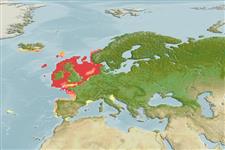Teleostei (teleosts) >
Syngnathiformes (Pipefishes and seahorses) >
Syngnathidae (Pipefishes and seahorses) > Nerophinae
Etymology: Entelurus: Greek, enteles, -es, -es = whole, perfect + Greek, oura = tail (Ref. 45335).
More on author: Linnaeus.
Environment: milieu / climate zone / depth range / distribution range
Ecology
Marine; brackish; demersal; depth range 5 - 100 m (Ref. 35388), usually 5 - 100 m (Ref. 35388). Temperate; 64°N - 30°N, 32°W - 14°E
Eastern Atlantic: Iceland and Norway to Azores and also enters Baltic Sea.
Size / Weight / Age
Maturity: Lm ? range ? - ? cm
Max length : 40.0 cm TL male/unsexed; (Ref. 6733); 60.0 cm TL (female); common length : 32.0 cm TL male/unsexed; (Ref. 4645); common length :45 cm TL (female)
Dorsal spines (total): 0; Dorsal soft rays (total): 0. Gill opening reduced to a pore located in the membrane above the opercle. Gill membranes fused to the body and isthmus. Superior trunk and tail ridges continuous, inferior trunk and tail ridges discontinuous, lateral trunk ridge confluent with inferior tail ridge. Brood area of male located under trunk. Rings: 28-31+60-69; Dorsal 37-47; Sub-dorsal 11-7+2-4; Caudal 4-9, rudimentary.
Adults inhabit inshore waters, among algae. Females with 1,000 or more ovarian eggs (Ref. 6733). Feed on small crustaceans and fish fry (Ref. 35388). Ovoviviparous (Ref. 205). The male carries the eggs in a brood pouch which is found under the tail (Ref. 205).
Males carry the eggs.
Dawson, C.E., 1986. Syngnathidae. p. 628-639. In P.J.P. Whitehead, M.-L. Bauchot, J.-C. Hureau, J. Nielsen and E. Tortonese (eds.) Fishes of the North-eastern Atlantic and the Mediterranean. Volume 2. Unesco, Paris. (Ref. 6733)
IUCN Red List Status (Ref. 130435: Version 2024-1)
Threat to humans
Harmless
Human uses
Fisheries: of no interest; aquarium: public aquariums
Tools
Special reports
Download XML
Internet sources
Estimates based on models
Preferred temperature (Ref.
123201): 7.3 - 12.5, mean 10.1 °C (based on 1036 cells).
Phylogenetic diversity index (Ref.
82804): PD
50 = 1.0000 [Uniqueness, from 0.5 = low to 2.0 = high].
Bayesian length-weight: a=0.00068 (0.00029 - 0.00157), b=3.00 (2.79 - 3.21), in cm total length, based on LWR estimates for this species & (Sub)family-body (Ref.
93245).
Trophic level (Ref.
69278): 3.5 ±0.44 se; based on food items.
Resilience (Ref.
120179): Medium, minimum population doubling time 1.4 - 4.4 years (tm=2).
Fishing Vulnerability (Ref.
59153): Moderate vulnerability (44 of 100).
Nutrients (Ref.
124155): Calcium = 28.5 [7.0, 92.4] mg/100g; Iron = 0.421 [0.179, 1.243] mg/100g; Protein = 3.09 [0.00, 6.80] %; Omega3 = 0.492 [0.223, 1.126] g/100g; Selenium = 9.58 [1.89, 27.88] μg/100g; VitaminA = 18.5 [7.2, 51.6] μg/100g; Zinc = 0.601 [0.300, 1.139] mg/100g (wet weight);
